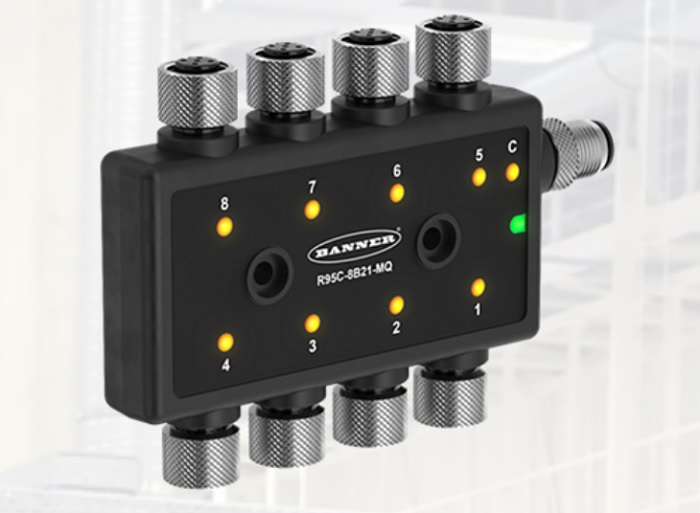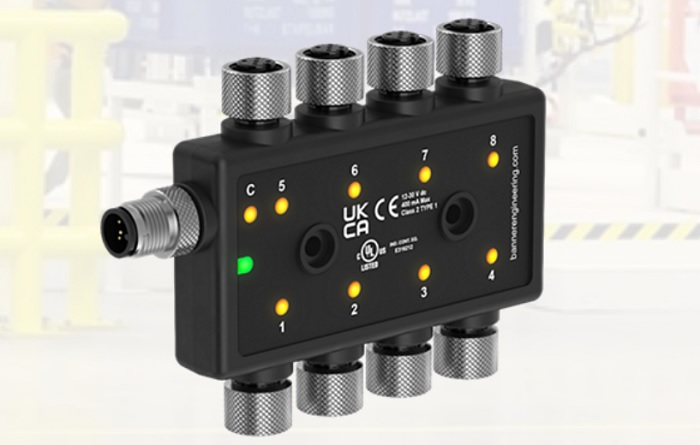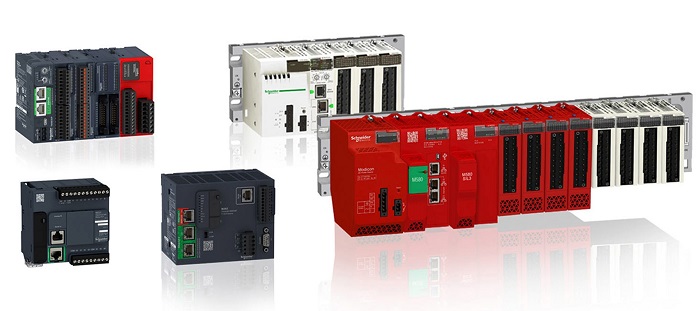Expanding I/O in the Field: Banner Engineering New Discrete Modbus Hub
Recently, Banner released a new lineup of eight-port discrete converters, allowing input of up to 16 different digital I/O devices and assigning them to pre-defined Modbus registers for ease of integration.
The Modbus Protocol
The Modbus protocol is a serial communication standard that became popular in the late 1970s with Modicon PLCs. The standard is still in use today because it is royalty-free and simple to deploy and maintain. While Modbus is a serial communication, it does support communication to multiple devices on the network at once, similar to Ethernet/IP or ProfiNet. Modbus traditionally used serial communication modes of ASCII and RTU, but more recently it is found riding on Ethernet TCP infrastructure, making it a popular choice for economical devices.

Banner Engineering’s new 8-port Modbus hub. Image used courtesy of Banner Engineering
Banner’s R95C 8-Port Modbus HUB
Field devices such as digital sensors need a path back to the PLC, typically this path involves installing a point I/O module in a panel that is mounted on the equipment. This solution takes up space and requires extensive wiring. Banner Engineering has a line of coverters that can transform the raw digital or analog signals and convert them to IO-Link.
Recently, Banner released the RC95C-8B21-MQ, which is an eight-port discrete converter. This device will take up to 16 different digital inputs and put them on pre-defined Modbus registers.
The PLC or other networked devices can then access these registers and read the sensor’s values. Each port can be configured as two inputs or one input and one output, meaning one R95C hub can support up to 16 inputs or 8 inputs and 8 outputs. With the ability to connect multiple hubs together, these devices can add a lot of I/O in a small footprint.
With the R95C being a smart device, it is capable of multiple on/off delays, one-shot or re-triggerable one-shot configurations, pulse stretcher, totalizer, and port mirroring, all of which are configured using the Modbus registers. The hub uses standard M12 threaded connections and comes with an IP65, IP67, or IP68 rating.

Banner Engineering’s new 8-port Modbus hub. Image used courtesy of Banner Engineering
Brownfield Equipment
The term “Brownfield” means equipment that has been in operation for quite some time. Adding functionality to brownfield equipment can be tricky. You don’t always get access to the PLC code and sometimes the network used on the equipment is outdated. A common example is data collection on brownfield equipment.
Twenty to thirty years ago, data collection on automation equipment was expansive and complex. Today, it is far less expensive and easier to accomplish. Typically you only need a few sensors to calculate OEE (overall equipment efficiency), so if the existing equipment uses Modbus adding some discrete sensors to an R95C Modbus hub allows a data engineer enough information to determine OEE on a machine that might be quite old.
With the ability to add smart logic inside the R95C the controls engineers will not require the existing PLC logic, nor will they need to make changes to it.

A current revision of the Modicon PLC: The PLC that began the original Modbus standard. Image courtesy of Schneider Electric
Inexpensive Protocols
RS-232, RS-485, and Modbus protocols are free to use, making them popular with devices that are inexpensive. Ethernet/IP, ProfiNet, and EtherCAT are protocols that require a royalty if they are used within a product. The free protocols work quite well and there are many converters on the market to switch back and forth between protocols, but thanks to Banner, you may not need to convert your protocol.
If your project is fairly small, and the PLC you have chosen uses Modbus, you might be able to devise an entire solution using only a few Banner Modbus converter hubs for your field inputs and outputs. Modbus is still a very stable and rugged protocol, and with the ability to communicate to multiple devices at once, it will feel just like a high-priced Ethernet protocol.

 Facebook
Facebook Google
Google GitHub
GitHub Linkedin
Linkedin








